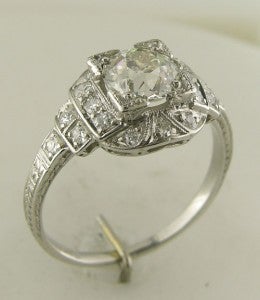First, spend sometime looking at images of vintage rings to get familiar with the styles of the era.
Second, look for the platinum/gold karat mark on the back of the ring, pin or brooch, using a jeweler's loupe to locate these small symbols. They may be faint due to years of wear and tear. Look for other markings that indicate the company or artisan.
Third, look at the stone's setting. Antique jewelry contains hand-cut diamonds and other gems. Baguettes and invisible settings were first used in the 1920s.
Last, look at the the way the diamonds were cut. Diamond cutting has changed significantly over time. Around 1875, stones were cut in the European-cut manner. The invention of the steam-powered lathe made the cutting faster and easier. This form of cutting continued until the early 1900s. The transitional-cut diamonds were used from around 1918 until the mid-1920s - a short frame of time that ended when the modern cut diamond was created. From the 1920s to the present day, diamond cutters use mathematical measurements to cut the diamonds with 56 facets to create the round brilliant stone that dazzles and dances.


